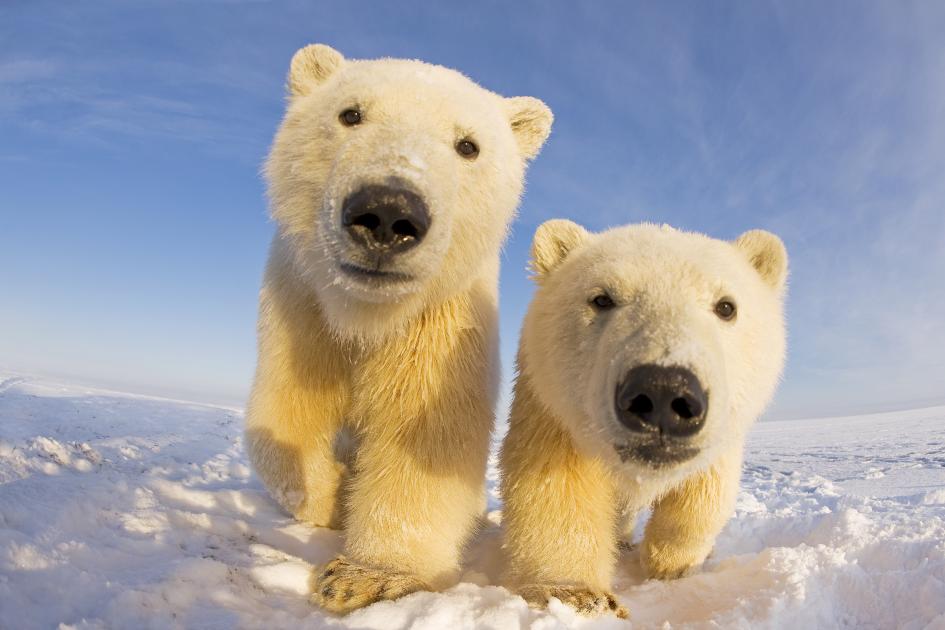Polar Bear: A Powerful Predator on Ice – An In-Depth Exploration of the Apex Arctic Predator

Introduction:
The polar bear (Ursus maritimus) stands as an iconic symbol of the Arctic, perfectly adapted to its extreme environment. Renowned as the largest land carnivore, the polar bear is a powerful and highly specialized predator, seamlessly navigating the frozen expanses of the Arctic. This extensive article aims to delve into the fascinating world of polar bears, exploring their biology, behavior, ecological role, and the conservation challenges they face in a changing climate.
I. Taxonomy and Adaptations:
- Taxonomic Classification: The polar bear belongs to the family Ursidae and is classified under the genus Ursus. It is the only bear species classified as a marine mammal due to its dependence on sea ice for hunting.
- Physical Adaptations: Evolved over millennia, polar bears showcase remarkable adaptations for survival in their harsh environment. Their white fur provides camouflage amidst the snow and ice, and their large, powerful limbs and paws aid in swimming and traversing icy terrain.
II. Range and Habitat:
- Arctic Habitat: The polar bear’s range is circumpolar, encompassing the Arctic Ocean and surrounding seas. Their habitat includes sea ice, coastal areas, and occasionally inland territories. Sea ice serves as a crucial platform for hunting seals, the primary food source for polar bears.
- Seasonal Movement: Polar bears exhibit seasonal movements in response to changing ice conditions. During the winter, they venture onto the ice to hunt seals, while in the summer, when the ice retreats, they may come ashore or remain on ice floes.
III. Feeding Ecology:
- Seal Predation: Polar bears are specialized predators of seals, particularly ringed and bearded seals. They rely on their keen sense of smell and powerful limbs to stalk and capture seals at breathing holes or break through ice to access seal dens.
- Hunting Techniques: Patient and skilled hunters, polar bears employ various techniques, including still-hunting near seal breathing holes, waiting near seal dens, and stalking seals on the ice. Their success in hunting is essential for their survival and reproductive success.
IV. Reproduction and Life Cycle:
- Mating Behavior: Polar bears typically mate between April and June, with males engaging in competitive and sometimes aggressive behavior to secure mating rights. Females exhibit delayed implantation, allowing them to time the birth of cubs to coincide with favorable conditions.
- Maternal Care: Pregnant females seek out maternity dens in snowdrifts or coastal areas to give birth during the winter. Cubs, usually born in December or January, remain with their mothers for an extended period, learning essential survival skills before venturing out on their own.
V. Threats and Conservation:
- Climate Change Impact: Climate change poses a significant threat to polar bears, as the reduction of sea ice limits their access to seals for hunting. Longer ice-free periods force bears to spend more time on land, leading to increased human-bear conflicts and reduced feeding opportunities.
- Pollution and Contaminants: Pollutants such as persistent organic pollutants (POPs) accumulate in Arctic ecosystems and affect polar bears. These contaminants can disrupt endocrine systems, weaken immune responses, and impact reproduction.
VI. Conservation Efforts:
- International Cooperation: Polar bear conservation involves international cooperation, with countries like Canada, Norway, the United States, Denmark, and Russia working together through agreements and organizations to protect polar bear populations and their habitats.
- Research and Monitoring: Ongoing research efforts involve monitoring polar bear populations, studying their behavior, and assessing the impacts of climate change. These studies contribute crucial data to inform conservation strategies and policy decisions.
VII. Human-Bear Conflict:
- Arctic Communities: Human-bear conflicts in Arctic communities arise as polar bears spend more time on land. These conflicts pose risks to both humans and bears and require innovative solutions, such as bear-resistant food storage and community education programs.
- Tourism Impact: The growing interest in Arctic tourism brings both opportunities and challenges. Sustainable tourism practices, including guidelines for observing polar bears, aim to minimize disturbance and ensure a positive coexistence between bears and visitors.
VIII. The Future of Polar Bears:
- Adaptation and Resilience: Polar bears face an uncertain future as climate change continues to reshape the Arctic. Their ability to adapt and find alternative food sources, coupled with effective conservation measures, will determine the resilience of polar bear populations.
- Global Conservation Responsibility: As flagship species for climate change impacts, polar bears symbolize the urgent need for global action to mitigate climate change. Conservation efforts must extend beyond polar bears to address broader environmental challenges affecting the Arctic ecosystem.
IX. Conclusion: Guardians of the Arctic Realm
The polar bear, a powerful predator on ice, epitomizes the resilience and adaptability of life in the Arctic. Their dependence on sea ice for hunting and breeding makes them vulnerable to the rapid changes wrought by climate change. The conservation of polar bears is not just a commitment to protecting a charismatic species but also a responsibility to safeguard the delicate balance of the Arctic ecosystem. As we navigate the challenges of a warming world, the fate of polar bears serves as a barometer for the health of our planet and the urgent need for collective action to preserve the icy realms they call home.




